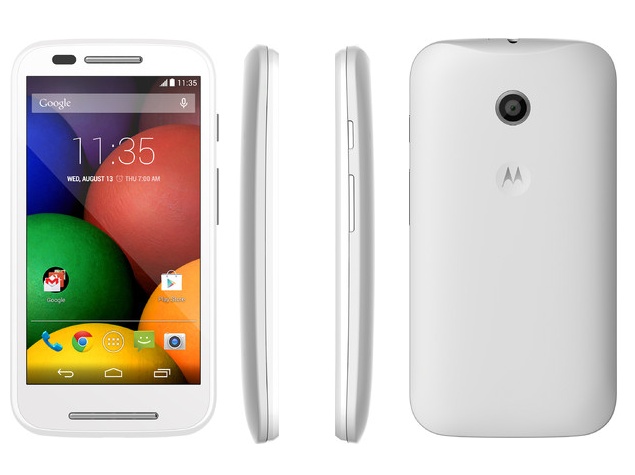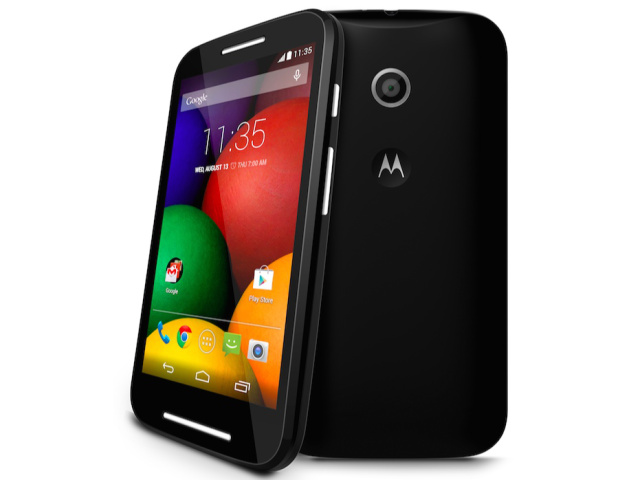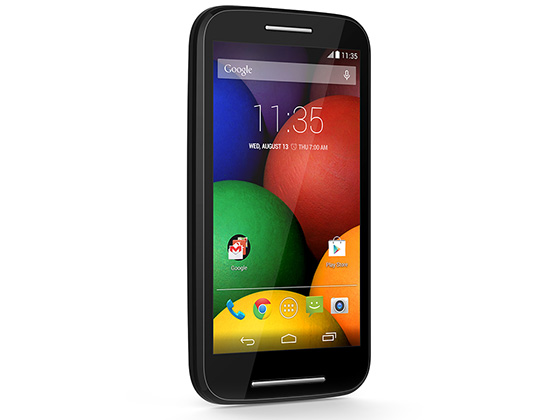Motorola Introduces the Moto E: The $129 Smartphone for Everyone
by Brandon Chester on May 13, 2014 7:51 AM EST- Posted in
- Smartphones
- Motorola
- Mobile
- Moto E
It doesn't seem like it was long ago that everyone was excited by rumors of a new Motorola phone after Google's short-lived acquisition of the company in May 2012. Motorola had long been known as a company that introduced their own custom interface onto Android which users felt offered little benefit in return for the performance impact it had on their devices. After their acquisition by Google it was hoped that Motorola would offer an experience closer to that of Google's Nexus devices. Those wishes came true, and Motorola has since been creating devices that are very close to stock Android with only minor modifications which, for the most part, are generally seen as helpful. Motorola also made a move for the mid-end segment of the market with the Moto G which offered users a formidable smartphone relative to its price.
Today Motorola has continued along their new path by introducing the Moto E, the most inexpensive device in their new lineup of smartphones.
| Motorola's Smartphone Lineup | ||||||
| Motorola Moto E | Motorola Moto G | Motorola Moto X | ||||
| SoC |
Qualcomm Snapdragon 200 (MSM8x10) 2x ARM Cortex A7 at 1.2GHz Adreno 302 at 400MHz |
Qualcomm Snapdragon 400 (MSM8x26) 4x ARM Cortex A7 at 1.2 GHz Adreno 305 at 450MHz |
Qualcomm Snapdragon S4 Pro (MSM8960Pro) 2x Krait 300 at 1.7 GHz Adreno 320 at 400MHz Motorola X8 System (SoC+NLP Processor+Contextual Processor) |
|||
| RAM/NAND | 1GB LPDDR2 + 4GB w/ MicroSDHC | 1GB LPDDR2 + 8/16GB NAND | 2GB LPDDR2 + 16/32GB NAND | |||
| Display | 4.3" 960x540 LCD | 4.5" 1280x720 IPS LCD | 4.7" 1280x720 RGB Stripe AMOLED | |||
| Network | 2G / 3G (MSM8x10 21.1Mbps HSDPA 850/900/1900/2100MHz or 850/1700/1900/2100MHz) | 2G / 3G (Qualcomm MSM8x26 21.1Mbps HSDPA) | 2G / 3G / 4G LTE (Qualcomm MDM9x15 UE Category 4 LTE) | |||
| Dimensions | 124.38 x 64.8 x 12.3mm, 142g | 129.9 x 65.9 x 11.6 mm, 143g | 129.3 x 65.3 x 10.4 mm, 130g | |||
| Camera | 5MP (2592 х 1944) Rear Facing |
5MP (2592 х 1944) Rear Facing w/ 1.4µm pixels and F/2.4 aperture 1.3MP Front Facing |
10 MP (4320x2432) Clear Pixel (RGBC) Rear Facing w/ 1.4µm pixels and F/2.4 aperture 2MP 1080p Front Facing |
|||
| Battery | 1980 mAh (7.52 Whr) | 2070 mAh (7.87 Whr) | 2200 mAh (8.36 Whr) | |||
| OS | Android 4.4.2 | Android 4.4.2 | Android 4.4.2 | |||
| Connectivity | 802.11 b/g/n + BT 4.0, USB2.0, GPS/GNSS | 802.11 b/g/n + BT 4.0, USB2.0, GPS/GNSS | 802.11 a/b/g/n/ac + BT 4.0, USB2.0, GPS/GNSS, DLNA, NFC | |||
| SIM Size | Micro-SIM (Dual SIM SKU) | Micro-SIM | Nano-SIM | |||
The Moto E sports a similar design to the other smartphones in Motorola's lineup with a rounded plastic design and a lip at the top for the 3.5mm headphone jack. Similar to the Moto G, customers will be able to swap out the back cover for ones of many different colors which adds a level of customization to the phone's design. I hope that Motorola has not compromised on the quality of construction to attain such a low price point; the Moto G felt exceptionally well crafted given its cost.
On the face of the device we have a 960x540 qHD display. Motorola isn't being forthcoming with whether or not this is an IPS panel, although they do confirm that it is covered with Corning Gorilla Glass 3. To attain its low price point the Moto E does not come with a front facing camera. There is also a large front facing speaker along the bottom of the device. On the back we have the 5MP camera which is capable of FWVGA (854x480) video recording, and the indented Motorola logo that has become standard across Motorola's new devices.
Inside the device we have Qualcomm's Snapdragon 200 platform with two Cortex A7 cores running at 1.2GHz and an Adreno 302 GPU at 400MHz. On the cellular side the device supports 21.1Mbps HSDPA on bands 1, 2, 5, and 8 for the North American and European versions and bands 1, 2, 4, and 5 in Latin America. A special SKU with support for dual SIM cards will also be available in certain markets with support for dual SIM standby. The device packs a 7.52 Whr battery and Motorola is promising that it will be capable of lasting you the day on a single charge. The device ships with only 4GB of NAND (only 2.2GB of which is available to the user) but to compensate Motorola has included a MicroSD card slot for up to 32GB of storage expansion.
Motorola is marketing this as the smartphone to kill the dumbphone and they have set up a website which encourages users to tell their friends still using flip phones to make the switch. The website states "Life before mobile apps should be a thing of the past. Introducing the Moto E. Made to last. Priced for all." It really is something to see such a capable device at a price accessable to the masses. It was only a few years ago that hardware of this capability was reserved for the fastest and most expensive of smartphones.
The Moto E comes with Android 4.4.2 out of the box. It is available now in the US and India for $129 USD and 6999 Rs respectively, with Motorola planning to launch in over 40 countries in the coming weeks.
Source: Official Motorola Blog













37 Comments
View All Comments
Spoelie - Tuesday, May 13, 2014 - link
Didn't anyone notice that the Moto X is actually sized sensibly compared to the others? It's lighter and thinner than both G and E, has the same width as the G and E, while the G is just as tall.Only the E is smaller _in one dimension_: it's 5mm less tall, not quite what you would expect for the reduction in screen size (and other specs)
coder543 - Tuesday, May 13, 2014 - link
Yep. If we look at volume, (multiplying out W x H x D and ignoring the curvature, which would only emphasize my point if taken into account), the Moto X is by far the smallest. The Moto X is at least a 10 to 15 percent reduction in volume compared to the other two devices, and volume is what you're gonna feel in your pocket, not screen size. That 4.3 inch screen everyone is pining for is paired with a phone larger in your pocket than the 4.7 inch Moto X.ciaphuas - Tuesday, May 13, 2014 - link
The Moto X, with its 4.7' sceen, has very small bezels making it feel like a smaller phone. The iPhone has huge bezels which is a waste of space.okashira - Tuesday, May 13, 2014 - link
The iphone needs its large bezels to make room for the "magic," under neath.Spuke - Tuesday, May 13, 2014 - link
Because no one wants one that's why. BUT the Sony Experia Z1 Compact is pretty much what those two people that are asking for that kind of phone is. Snapdragon 800 with a 4.3" screen. You're welcome!Impulses - Tuesday, May 13, 2014 - link
Actually, I was torn between a Nexus 5 and a Moto X and the latter's smaller size was a big part of the reason... Ultimately went with the N5 for the newer hardware and Sprint Spark, but it was close.phoenix_rizzen - Tuesday, May 13, 2014 - link
Actually, it's because no one offers one! You can't buy what isn't for sale.A lot of people want smaller phones with flagship internals. A lot of people want qwerty sliders with flagship internals. But, nobody offers those, so nobody can buy them, so everyone is forced to settle for either monster phones with skookum internals, or small phones with crap internals.
Spuke - Tuesday, May 13, 2014 - link
Ever heard of demand? The phone makers make big screen phones because people WANT them. Screens started small and got bigger and people kept buying. If people wanted small screens, en masse, then the initial big screens would've flopped and the manufacturers would've kept them small. What you say makes ZERO sense.rish95 - Tuesday, May 13, 2014 - link
That's because they give us no options. I bought a 4.0" phone in mid-2011. All of my Android flagship upgrade options in mid-2013 had much bigger screens.The Moto X was 4.7", the HTC One was 4.7", the Nexus 4 was 4.7", S4 was 5.0".
I'm not going to "upgrade" to a phone with a junk SoC like the S4 Mini, so I had no choice but to buy a phone with a big screen.
These phones are selling because there aren't any options. People aren't just going to say "Fuck it, I'll keep my Galaxy S" when their contracts are up.
Trixanity - Tuesday, May 13, 2014 - link
Sony Xperia Z1 Compact?